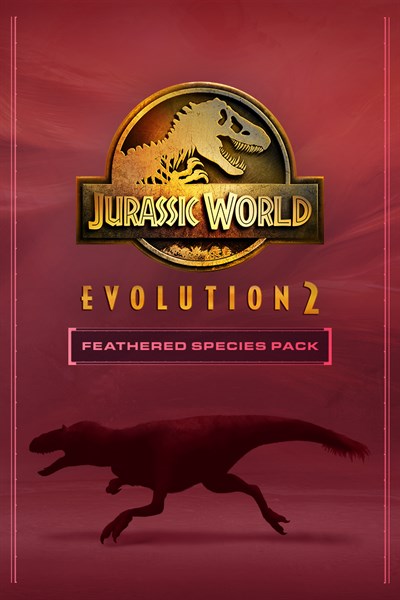Jurassic World Evolution 2: Feathered Species Pack Available Today

Summary
- You can expand your park by adding beautifully feathered reptiles or dinosaurs
- We take a deeper dive into the four most impressive prehistoric species.
- Xbox One and Xbox Series X|S
With the addition of The Imagination Park, your park will be even more impressive and diverse. Jurassic World Evolution 2 Pack: Feathered Speies. Containing four incredible feathered species in total, you’ll bring a whole new dimension to your park by showcasing these stunning dinosaurs and reptiles, from nimble flying species to land-roaming meat-eaters. Let’s dive deeper into the Feathered Species Pack.
We’re paying tribute to a mix of species that rank as firm favorites, both amongst the community and with everyone here at Frontier Developments. Our Community Team created a list of wish lists for all species, and the Yutyrannus, Deinocheirus, were high up. The smaller Jeholpterus, Sinosauropteryx and Sinosauropteryx also resonated well with our animation, concept and character teams.
The Jurassic World Dominion film brought feathered animals to life. My goal was for the next dinosaur-focused group to be able to highlight species such as this. Science is continually evolving our knowledge of extinct lifeforms, and over the last few decades, we’ve learned a tremendous amount about what they could have looked like. This means we’re ensuring every species in the Jurassic World Evolution franchise is as authentic as possible, and it’s great to use this knowledge in order to bring four more exciting and beautiful species to players in this pack.
This pack has a wide range of species, from large ornithomimosaurids to medium-sized theropods to the smallest yet with Jehelopterus as well the Sinosauropteryx. No matter your preferences, the sheer diversity of the species in this pack means there’s something for everyone.
Yutyrannus, The ‘Feathered Tyrant’

The Yutyrannus is one of the most large known feathered dinosaurs that eat meat. For insulation, Yutyrannus’s coat is light and dense. This helps keep it warm during colder temperatures. I’m especially thrilled with how this looks in the game – try getting a close-up shot using the in-game camera! The name Yutyrannus translates as ‘feathered tyrant’, and it has truly earned that name, being the most fearsome inclusion in this pack.
Jeholopterus is rare and easily accessible by air.

My personal favorite, the Jeholopterus, is next. This rare and endangered reptile has been found in one instance by Palaeontologists so far. However, the specimen was extremely well preserved which allowed us to get fascinating details about its appearances and behaviors. Jeholopterus, as the smallest species of airborne in the entire game is, is astonishingly fast and agile. The Jeholopterus looks like a hybrid of a bird and a bird.
Deinocheirus is an omnivore and humphunter

Then there’s the Deinocheirus, a highly requested community favorite. You will be able to see the reason for this unique plant-forager by just looking at it. This is the largest known ornithomimosaur, and it has a duck-like body with hump. It also has arms that are longer than any bipedal dinosaur. It is the first omnivore ever to be able to consume both fish feeders and paleobotany trees. This gives you many options to meet its nutritional needs.
Sinosauropteryx is small but very powerful

We now turn our attention to the Sinosauropteryx. This is the species that sits at the other end of the spectrum from the Deinocheirus. It’s also the smallest member of our pack. It’s a diminutive, meat-eating dinosaur covered with delicate, hair-like feathers and waving a striped tail. Because it hunts in small groups, the Sinosauropteryx has no size issues and is therefore a powerful species. It’s also a landmark in the field of feathered dinosaur research. The fossilized remains of the dinosaur were among the first to confirm the existence and potential coloration of feathered dinosaurs.
By continually researching and comparing how equivalent sized modern day birds look and move with their feathers, we’re able to refine our art processes and pipelines to ensure that our species look as realistic as possible. I’m immensely proud of how we’ve managed to capture these four amazing prehistoric species, and I can’t wait for you to get your hands on them.
It’s been really exciting to bring such unique species to life, and expand on the astounding amount of dinosaurs and reptiles that are currently in the game. You can use them to improve your park’s appearance.Jurassic World Evolution 2 Pack: Feathered SpeiesS and Xbox One on 30 March.|S and Xbox One on 30 March.
Jurassic World Evolution 2 Pack: Feathered Speies
Frontier Developments
$7.99
Jurassic World Evolution 2 – Feathered species pack expands your Jurassic World. These four prehistoric animals, which include three terrestrial dinosaurs and one flying reptile are stunning in their plumage. They all have a variety of fine to dense coats. Evolve your park like never before and give your guests an experience they won’t forget with these captivating feathered additions.
The pack includes:
· Yutyrannus has a name that translates as ‘feathered tyrant’ due to it being one of the largest known feathered dinosaurs to eat meat. A striking nose crest and dense yet lightweight coat are its distinguishing features.
· Jeholopterus is an impressively quick and nimble flying reptile, and the smallest airborne species in the entire game. While only one specimen was found so far by paleontologists, we have a great insight into the species’ looks and behaviour.
· Deinocheirus is one of the largest ornithomimosaurs ever discovered, with arms longer than those of any bipedal dinosaur. Even though it eats only plants, this prehistoric species is distinctive with its distinctive duck-like bill, broad hump, and large back.
· Sinosauropteryx, a small, meat-eating dinosaur covered with delicate, hair-like feathers and waving a striped tail. Sinosauropteryx hunts in groups. The discovery of this dinosaur in 1996 was a major milestone. Its ancient remains suggest that there were feathered dinosaurs and hint at the possibility for colouration.
#Jurassic #World #Evolution #Feathered #Species #Pack #Today









